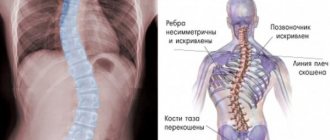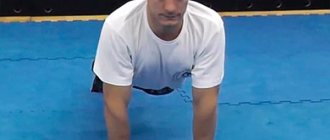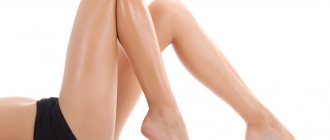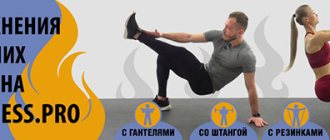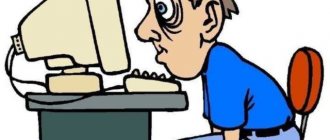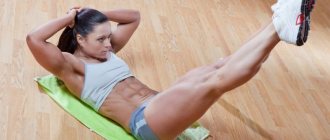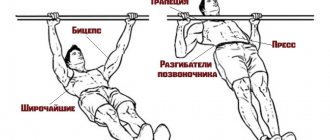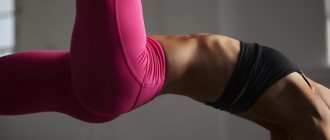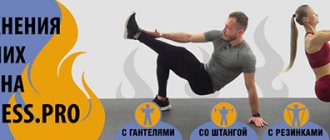Exercise therapy in a standing position
- Arms along the body, feet shoulder-width apart. Slowly bring your shoulder blades together, then relax them.
- The position of the hands is on the belt. Raise your knees alternately, pressing them to your chest. Repeat for 60 seconds.
- Raise one hand and move the other to the side. On a deep inhalation, lift your body. Repeat 10 times, alternately changing the position of your hands.
- Move the leg on the side of the scoliosis formation to the side. Place your hands behind your neck. Straighten your elbows, bend your torso. Do 8 times.
- Stand on your toes with your arms raised up. Stand for 10 seconds.
- Do lunges alternately on each leg. Your hands should be pointing upward.
- Place your feet shoulder-width apart. Start slowly squatting, while stretching your arms forward.
Did you know that such a method of therapy as therapeutic gymnastics appeared back in the 1st century. BC, and it was proposed by Celsus Aulus Cornelius, a Roman physician and philosopher.
Prevention of scoliosis
According to statistics, scoliosis is observed in almost 30% of schoolchildren aged 7 to 9 years, and in almost half of adolescents aged 10-14 years, so prevention of spinal diseases should be carried out from a very early age.
The list of provoking factors for the development of pathologies of the spinal column includes
Wrong clothes or shoes
Tight T-shirts and trousers, which interfere with the proper development, first of all, of the thoracic spine; shoes that are too big or too small. Things should be spacious, and sandals or sneakers with a small heel, arch support, orthopedic insole.
Sleeping place The baby's bed should be hard, the mattress should be orthopedic, and the pillow should be small in size and moderately soft. It is better to sleep on your back or stomach. Lifting and carrying loads The biggest danger is a school backpack. This school item must have a rigid back, wide straps, ensuring an even load of weight on the back
An important point is that the backpack must be selected strictly according to size. Desk lighting For schoolchildren, it is important to choose the light so that it falls on the left side; the desk or table, as well as the chair, must correspond to their height. While doing homework, it is important to ensure that the child does not cross his legs or rest his head on his hands. Physical activity
Already starting from kindergarten, the baby should be accustomed to regular sports. At first, this could be active games for 5-10 minutes every hour, swimming in the pool, river, figure skating, dancing. Martial arts, football, and basketball are well suited for school students. If going to the gym or sports section is impossible for some reason, a sports corner should definitely be equipped at home.
An ideal solution would be a wall bar, a simple horizontal bar or a fitball (a special gymnastic ball), exercises on which will help strengthen all muscle groups and will be an excellent tool for performing exercises to prevent or treat scoliosis.
Rules for exercise therapy for scoliosis
There is no difference between gymnastics for scoliosis for patients of different ages; it can easily be done at home or in the gym. The trainer will suggest an individual set of exercises that do not require special physical training or sports skills. The main thing is to follow the rules:
- perform movements slowly, start with small loads, moving to more serious ones gradually, as the muscles strengthen;
- stop movement if it causes pain;
- listen to yourself - when moving, you should feel the stretching of the ridge;
- alternate elements for different parts of the spine, passive and active exercises;
- do gymnastics regularly.
It is very good if exercise therapy is supplemented with massage courses, some sports, and in difficult situations - wearing a special corset.
Gymnastics for posture possible consequences and complications
The main condition for exercising exercise therapy remains a mandatory prescription by a doctor. Only a specialist, after an appropriate examination, makes a decision on prescribing therapeutic exercises with determining the place of this method of therapy in the overall complex, the composition of classes, their structure, degree of load, frequency, etc. If necessary, gymnastics is carried out only in the presence of an instructor or doctor. If these conditions are not met, or you turn to exercise therapy, neglecting medical indications, then possible consequences, such as attacks of pain, deterioration in well-being, pressure surges, progression of the disease, the appearance of new symptoms, curvature of posture, will not keep you waiting long. To prevent this from happening, you must strictly follow the doctor's instructions and not self-medicate.
Exercises for spinal scoliosis at home
The most commonly diagnosed disease among adolescents and primary schoolchildren is scoliosis. Children are burdened with school work, lessons, computer games - a sedentary lifestyle that leads to a slow but sure deterioration in the condition of the back muscles. Weak spinal muscles are not able to support the spine in the correct condition, which leads to curvature of the latter.
The right approach to treating scoliosis
Scoliosis is diagnosed by doctors, and all treatment procedures are prescribed by them. To enhance the effect, you can perform some exercises at home. Regular physical examinations for school-age children are key to early detection of scoliosis. The onset of the disease leads to a fairly rapid progression of curvature.
The main goals of treatment measures:
- Stop the progression of scoliosis.
- Improve the condition and position of the spine.
- Strengthen your back muscles.
- Correct the curvature.
Physical exercise and massage alone will not be enough, so parents should follow several rules to improve the condition of the child’s spine.
- Take walks in the fresh air. Walking strengthens your back muscles.
- Introduce hardening procedures into the rule.
- Follow the principles of proper nutrition, with sufficient amounts of protein and vitamins in the diet.
- Using a hard orthopedic mattress.
- Maximum control of the child's posture.
Features of scoliosis treatment
Scoliosis is treated in accordance with 4 degrees of the disease. For each degree, doctors select their own methodology.
- Therapeutic physical exercises aimed at strengthening muscles and restoring posture.
- Massage procedures and wearing a corset are added to the classes. An orthopedic corset can be worn only on the recommendation of a doctor, for a certain period of time.
- In addition to the enhanced measures from the previous two points, surgical intervention is possible to correct the curvature of the spine.
- Scoliosis at the last stage is corrected exclusively by surgical methods.
To strengthen muscle tissue
- From a lying position on your back with your legs bent and resting on the floor. The pelvis is raised, 6 approaches.
- Exercise “bicycle” - 1 set of 30 seconds.
- From a lying position on your back, lift your legs up one at a time at an angle of 45C, 10 approaches.
- From a lying position on your back, describe a circle with both legs, lifting them, 10 approaches.
To strengthen the entire back
- From a lying position on your stomach, raise your legs, bending them at the knee, 10 approaches.
- The same exercise, but bend both legs at the same time, 10 approaches.
- From a lying position on your stomach, straighten your arms with emphasis on them, arching your back, 10 approaches.
- “Swallow” - raised legs are added to the previous exercise, 1 approach with a delay of 30 seconds.
- From a lying position on your stomach, lift your straight legs up one at a time, 10 approaches.
Physical exercises that you should not do
- Jumping
- Stretching and flexibility exercises
- Strength training and weight lifting
- Hanging on the bar and any stretch of the spine.
How to competently develop a set of exercises
In order for exercises to eliminate scoliosis to really help, when developing a complex you need to adhere to a number of rules:
- It is necessary to exclude any exercise that, in case of scoliosis, can aggravate the condition of the spine or lead to minor injuries. Undesirable ones include all types of strength exercises with weights, dumbbells and barbells, somersaults, jumps, jumps, pull-ups and hanging on the crossbar; Fast running is also not recommended.
- Exercises to eliminate signs of scoliosis are done at a slow pace. Sudden jerking movements can lead to muscle strain and back pain. The patient must constantly listen to his body and monitor its reaction to physical activity.
- There is no need to perform many approaches at once. The load should be increased gradually so as not to overstrain the back muscles.
- Each exercise prescribed for scoliosis should be designed for passive traction of the spine.
- To ensure an even load on the muscles, you need to alternate exercises for the shoulder girdle with exercises for the lumbar region.
A set of exercises for scoliosis includes three stages:
- A warm-up exercise that is recommended for scoliosis to prepare ligaments and muscles for stress. It helps stimulate blood circulation and set the correct breathing rhythm.
- Basic loads. They are performed to correct spinal deformities. In addition, they restore muscle tone and promote the normal functioning of internal organs.
- Final exercises that restore the usual breathing rhythm and relax the muscles.
Complex of physical therapy for scoliosis
Exercises for the back for scoliosis are selected taking into account all the specifics of the disease.
With thoracic scoliosis and curvature of the lumbar spine, it is necessary to develop the muscles in this particular area, which will compensate for the distortion and stabilize the spine.
With scoliosis of the 1st degree, various symmetrical exercises and various sports are possible, except for those prohibited above.
For grade 2 scoliosis, a set of exercises is aimed not only at strengthening the stability of the spine, but also at developing muscles and correcting the deformity.
With grade 3 scoliosis, the technique is no longer only aimed at eliminating or maximally correcting the deformity, but also at improving the patient’s overall physical performance. This is a complex set of general strengthening and corrective exercises.
Scoliosis is asymmetrical. There are curvatures to the right and left. For left-sided scoliosis, gymnastics is aimed at maintaining balance and improving balance, and, therefore, performing asymmetrical exercises with a bias to the right. Accordingly, with a right-handed one, you need to do the same thing, but with a bias to the left.
Exercises for scoliosis in children are simpler than in adults, and are also based on a comprehensive approach.
An approximate set of exercises for scoliosis
As a rule, each set of exercises consists of four stages: warm-up, exercises that are performed on the back, stomach and standing.
Rest should be carried out in the starting position, that is, in which position you do the exercise, you should rest in that position. If you do it on your back, you also rest on your back; if you do it while standing, you rest accordingly while standing.
Exercise No. 1 – warm-up
Typically, each complex of physical therapy begins with unloading the spinal column. We get down on all fours and walk. Duration: no less than three minutes, but no more than five.
Next come the exercises, which should be performed from a supine position. They help develop and stretch the abdominal muscles.
Exercise No. 2
We lie down on the floor (to make it as comfortable as possible, you can lay out a fitness mat), arms along the body. Now we begin to stretch our heels down and our heads up, trying to stretch our spine.
The number of repetitions is four stretches, each of which lasts at least 15 seconds.
Exercise #3
Example exercises
These movements are familiar to each of us from school physical education lessons, called “Bicycle”. We lie down on the floor, take our arms back and lock them behind our heads. We perform circular movements with our legs, simulating riding a bicycle.
For this exercise to be as effective as possible, you need to move your legs not above the level of your abs, but slightly below, bringing them closer to the floor. Number of repetitions: three sets of one minute each.
Exercise #4
Without changing the starting position, we perform cross movements with our legs, simulating the work of scissors. Such movements are usually recommended for right- or left-sided scoliosis. Number of repetitions: three sets of one minute each.
Next, we begin to perform exercises from a lying position on the stomach, thanks to which you can strengthen the muscle tissue of the back.
Exercise #5
We lie down on the floor, stomach down, arms along the body. Now we begin to stretch our heels down and our heads up, trying to stretch our spine.
The number of repetitions is three stretches, each of which lasts at least 15 seconds.
Exercise #6
We straighten our legs, place our hands in front of our face, palms on the floor, after which we lower our chin onto our hands, so that the neck is in a relaxed state. Now slowly raise your head, torso, arms and legs, trying to bend in the lumbar region.
We fix this position and begin to imitate the movements that are typical for breaststroke swimming:
- we stretch our arms forward and spread our legs to the sides;
- we spread our arms to the sides and bring our legs together;
- we pull our arms to the shoulder joint, and still keep our legs together.
Between each approach you need to take a break, but no more than 10 seconds. Number of repetitions: three sets of 12 times.
Without changing the starting position, we repeat exercise No. 4.
Number of repetitions – 3 sets of half a minute.
Exercise #8
We lie down on the floor with our stomach down. We straighten our legs, place our hands in front of our face, palms on the floor surface, after which we lower our chin onto our hands, so that the neck is in a relaxed state.
Now we simultaneously raise the upper part of the body and legs, trying to bend in the lumbar region. You need to rely only on your abs, with your arms and legs at the top. Now we spread our arms to the sides and bring our legs together. We fix this position for a quarter of a minute, after which we slowly return to the starting position.
It is very important that while performing these body movements, the hips are in weight. The number of repetitions is at least three approaches, taking a 10-second break between each of them. And the final two exercises should be done from a standing position
And the final two exercises should be done from a standing position.
Exercise #9
We stand straight, place our palms on our shoulders, while spreading our elbows to the sides. If possible, this should be done while standing in front of a mirror, since this is how you can control your posture.
Now we begin to rotate our hands clockwise
It is very important not to make sweeping movements with your elbows; try to make them describe a small circle. Number of repetitions: three sets of half a minute, resting no more than 10 seconds between each
Exercise No. 10
We stand straight (preferably in front of a mirror), spread our arms to the sides so that our palms “look” up.
Now, at a slow pace, we rise onto our toes, after which we squat (but not to a full squat), and again stand on our toes. The number of repetitions is at least 10 times.
Be healthy and happy!
What exercises to choose for scoliosis?
With scoliosis, the spine is curved along the axis of the frontal plane, which leads to asymmetry of the left and right parts of the torso. This results in a difference in the load experienced by the muscles on different sides: on the convex side they are in constant tone, and on the concave side they are relaxed.
To eliminate deformation, you need to balance the load on all muscle groups, strengthen them and create a dense frame around the spine.
To engage all muscle groups, you need to do different types of exercises:
- Asymmetrical. They are developed taking into account the degree of curvature of the spine and allow you to maintain the tone of the “lazy” muscles on the concave side.
- Symmetrical. They are selected in such a way that equal muscle load on the left and right leads to alignment of the spine.
- Detorsion exercises that relieve muscle tension and relax them.
- General strengthening. These exercises are used to develop and strengthen the body, increasing its endurance.
The standard exercise therapy complex should include all types of exercises against scoliosis.
Restrictions when practicing physical therapy
Drug treatment can only to a small extent affect the pathological process. The entire emphasis is on therapeutic exercises. The exercises are designed to, if not completely, then at least partially restore the normal configuration of the spine. In addition, the muscle corset is strengthened, blood flow through the vessels is improved, and the functioning of internal organs is normalized.
But therapeutic exercises can bring not only benefits, but also harm. The following are contraindicated exercises for scoliosis:
- Running is a relative contraindication. You can run only with a slight to moderate curvature of the spine. Running is prohibited with scoliosis of 3-4 degrees, as well as with a rapidly progressing process.
- All exercises performed on one leg, be it standing, lunges forward and to the side with or without dumbbells. These exercises negatively affect the configuration of the pelvis, which is already curved due to scoliosis.
- For the same reason, it is forbidden to sit in the lotus position. This pose involves twisting the legs at the knee joints.
- Somersaults are too dangerous in terms of injury even for a normal spine. Therefore, in case of scoliosis, they are strictly contraindicated.
- Dancing and gymnastics create a high, uneven load on the spine. Therefore, if it is bent, it is contraindicated.
- All exercises that involve a vertical axial load on the spine and circular movements with turns are prohibited.
- Outdoor sports games (football, badminton, volleyball) are also contraindicated. Some of them are associated with fast running, while others are associated with rapid turns of the body.
A natural question arises: what is allowed then? You can get the answer to this question from a physical therapy specialist. After all, all health-improving gymnastics for scoliosis are carried out on his recommendation and under his personal supervision.
A set of exercises for the back for scoliosis, treatment at home
One of the common diseases of the spinal column among children, adolescents and young people under 25 years of age is scoliosis.
The pathology develops against the backdrop of many negative factors, and experts associate the fact that the disease has recently been rapidly “getting younger” with the development of computer technology and a decrease in the physical activity of the population.
Exercise therapy for scoliosis and restorative gymnastics today are the main methods of treatment and prevention of this pathology.
Important!
Before you start doing exercises or gymnastics for spinal scoliosis at home, you should figure it out.
How can they help against scoliosis, what exercises can be done, what should not be done, and what exercises are most effective for curvature of the spine.
To answer these and other questions, one must understand the underlying etiology of the pathology.
Congenital, acquired, post-traumatic deformation or curvature of the spine is called scoliosis. The risk group includes all young people aged 6 to 25 years.
This disease most often occurs in children and adolescents under the age of 16, and it is noted that the female half of the population suffers from this pathology 3-6 times more often.
To date, there is no reliable data on the main causes of the disease. In 80% of cases, a diagnosis of idiopathic scoliosis is made. Translated from Greek it means “for an unknown reason.”
This type of pathology should not be confused with infantile scoliosis, which develops in children under one year of age and usually disappears on its own. A form of idiopathic scoliosis usually develops in adolescence during the most active phase of human skeletal growth.
Based on the time of manifestation, location and severity of the course, the pathology is divided into several types. However, the general criterion for its presence in a person is one thing - a degenerative change in the bone and muscle tissue of the spine, which leads to its three-plane deformation.
Experts call the main negative factors in the development of the disease:
- Sedentary lifestyle;
- Metabolic disease;
- Weakness of skeletal muscles;
- Spinal column injuries.
Therapy for the disease is to relieve excess tension in the muscles, eliminate their stiffness and strengthen the overall weight of the musculoskeletal corset. It is to solve these problems that special gymnastics and exercise therapy complexes used for scoliosis were developed.
Physical therapy for scoliosis is one of the main methods of treating this pathology. However, for its more effective use, it is used in combination with corsetotherapy and physiotherapeutic procedures.
In particularly severe cases of the disease, to correct posture, they resort to surgery and fixation of the vertebrae with metal implants.
Gymnastics for scoliosis at home
What is scoliosis?
There are the following types of bends and deformations of the spine - anteriorly (lordosis), posteriorly (kyphosis), in one direction or another (scoliosis). A person has 4 physiological curves - 2 lordosis (cervical and lumbar) and two kyphosis (thoracic and sacral). There is no scoliosis among the physiological curves.
Thus, any, even barely noticeable, curvature of the spine to the right or left is certainly a pathology. Most often, scoliosis develops as a result of systematic violations of posture in childhood and adolescence. But this is far from the only cause of spinal curvature.
Scoliosis can develop after a spinal injury. Sometimes the spine is bent due to various endocrine diseases and vitamin deficiencies with impaired absorption of calcium supplied with food. And in some cases, scoliosis develops in childhood for an unknown reason.
Exercises for different types and degrees of scoliosis
Each type of pathology has its own characteristics when performing classes, but only a specialist will select a complex based on the severity and type of disease. There are exercises that are effective for curvature of the spine, the duration and intensity of which will also be determined by the doctor.
| Department | Exercises |
| Exercises for the cervical spine |
|
| Therapeutic gymnastics exercises for the thoracic spine |
|
| Training for the lumbar spine |
|
What are the chances of success in the fight against scoliosis?
What results can you expect from exercise therapy? Exercises prescribed for treatment of scoliosis will help restore strength and elasticity to the muscles, stop further deformation of the spine, and in the initial stages of the disease completely eliminate lateral curvature. They are also suitable for general strengthening of the body: they activate the work of the heart and blood vessels, and improve the functioning of the lungs.
Exercise therapy to correct posture is considered a conservative treatment method. However, despite the constant development of medicine, it will never lose its relevance.
- For scoliosis of the 1st degree, exercise therapy can be an independent therapy that will help cope with the disease. About 90% of patients with grade 1 scoliosis are cured only with the help of exercise therapy.
- In the 2nd degree of the disease, complex exercises for the treatment of scoliosis should be accompanied by massage, exercise in the pool, and sometimes by wearing a special corrective corset.
- Stage 3 and 4 scoliosis in adults cannot be cured at home. Only surgery will help here. But, in addition to surgical intervention, the orthopedic doctor always prescribes exercises that will not help cure scoliosis, but will support the body and prevent the disease from progressing.
There are exercises recommended for scoliosis that are designed specifically for children. The fact is that a child’s spine is more flexible and mobile than an adult’s spine, so any impact on it must be careful and professional. Under no circumstances should you come up with a complex of exercise therapy for children on your own, at home.
Only after consultation with a specialist can a child with grade 1 scoliosis be allowed to perform exercises at home. More severe violations are corrected under the supervision of a doctor. If the child does not have a deformity, the specialist will still recommend exercises to prevent scoliosis.
Back exercises for scoliosis should be performed regularly. Only then will the treatment bear fruit.
General restrictions
Certain daily activities also have a detrimental effect on the spine. It is worth highlighting the two most important points that people with scoliosis should avoid:
- Long fixed body position. The position should be changed at least once every 20 minutes (it doesn’t matter whether you are sitting or standing), especially if the body experiences discomfort.
- Carrying a bag, package, case in one hand. Preference should be given to a backpack (put it on your shoulders) or evenly distribute the load into two bags to carry them in both hands.
It will also be useful to familiarize yourself with the basic rules for preventing scoliosis, which can be found here at the end of the article. This will in most cases avoid further progression of the disease!
Therapeutic gymnastics in some cases may be contraindicated in whole or in part, until the risk factors for complications are eliminated. Some patients can perform exercises only in a physical therapy room, under the supervision of a specialist. All this is determined by the attending physician during the examination, but it is impossible to independently assess the health risks.
Some patients should exercise under the supervision of a physical therapy doctor
The main contraindications for prescribing exercise therapy are:
- scoliosis 4 degrees;
- accelerated progression of the disease;
- serious dysfunction of the cardiac or respiratory system;
- high intracranial pressure.
Scoliosis 4 degrees
Reasons for temporarily stopping classes:
- exacerbation of chronic diseases;
- infectious and colds accompanied by high fever;
- postoperative period;
- increased pain in the spine after physical activity.
If you experience severe pain, stop training temporarily.
Exercises should not be performed until the condition has stabilized, so as not to provoke deterioration. If pain or discomfort is related to your back, be sure to tell your doctor and do not try to solve the problem on your own. The spine contains many nerve endings that are often pinched due to deformation of the vertebrae.
Regardless of the degree of the disease, the following are prohibited for scoliosis:
- Maintaining the body in the same position for half an hour or more. It is necessary to change your position, do a light warm-up and try to perform a small 5-minute set of exercises to relax your back every 1-2 hours.
- Carrying a heavy weight in one hand. It is preferable to carry loads in a backpack or bag that can be hung on your back. The maximum severity standards are determined by a specialist - in different cases they will be different.
- Performing heavy physical work associated with constant stress on the back. Such conditions can not only greatly worsen posture, but also lead to the formation of intervertebral hernias, which are most often removed only through surgery.
- Exercises on horizontal bars and any exercises that involve traction of the spine are strictly prohibited.
- Any sports activities that involve heavy loads, sudden movements, or injury are completely excluded: somersaults, strong jumping, boxing, hockey, gymnastics and other sports.
- Fitness classes must be coordinated with a doctor: lifting weights and sharp turns of the body can negatively affect the health of the back.
PLEASE NOTE – Self-treatment of the disease is possible only in the earliest stages. If scoliosis of the 2nd degree and subsequent ones is detected, you cannot do without diagnosis and consultation with a specialist.
Scoliosis is one of the most common postural disorders. The disease develops gradually and has several stages.
There are almost always certain contraindications for scoliosis, so it is important for the patient and loved ones to have a good idea of what cannot be done with scoliosis and what is possible.
The fact is that some physical activity for scoliosis is beneficial, while others, on the contrary, contribute to the development of pathology.
Check out the article: Exercises for stage 1 scoliosis
With scoliosis, not only the spinal column suffers, but also the internal organs due to the asymmetry of the chest. In addition, when the spine is curvature, intervertebral discs and nerves are compressed, which leads to osteochondrosis and disc hernias. Contraindications for scoliosis are due to excessive muscle tension on one side and relaxation on the other. In this regard, with scoliosis it is not advisable to:
- Standing or sitting for a long time in any one fixed uncomfortable position
- Run fast
- Carry heavy weights in one hand
- Make sharp circular movements
- Wear tight clothes.
Therapeutic exercises for scoliosis
Grades 1 and 2, as a rule, are treated with the help of special exercises, which the patient is recommended to perform daily, although the shape of the curvature of the spine also matters, therefore, before self-medication, you should visit a doctor to establish an accurate diagnosis, as well as discuss with him the recommended training.
Basic rules for performing exercises for scoliosis:
- The load should be moderate, since overstraining the back muscles will lead to the progression of the disease;
- The increase in loads should occur gradually;
- Gymnastics is performed at a moderate and even slow pace;
- Stretching the spine on the crossbar is prohibited, so it should not appear in the exercises as a gymnastic attribute;
- It is not recommended to perform rotational movements and those aimed at increasing the flexibility of the spine.
Exercise No. 1 - warm-up
Any gymnastics should begin with preparing the muscles for subsequent loads. In this case, it is recommended to walk on all fours for 3-5 minutes.
Exercise No. 2 – spinal traction
You need to lie on your back and stretch your heels down and your head up. Each stretch should last 10 seconds, number of repetitions 3-5.
Exercise No. 3 – bicycle
While lying on your back (arms along your body or behind your head), you need to raise your legs and bend your knees. Next, we begin to imitate riding a bicycle.
When performing this exercise, it is important to pay attention to the fact that the legs are not above the stomach, but below it, that is, at a minimum distance from the floor. The duration of the “bicycle” is 40 seconds. Number of repetitions - 3
Number of repetitions - 3.
Exercise No. 4 – scissors
We continue to lie on our backs, with our arms extended along our torso or behind our heads.
It is necessary to perform cross horizontal and vertical swings with your legs
It is important that horizontal movements are made at a minimum distance from the floor
Duration – 40 seconds. Number of repetitions – 3 sets.
Exercise No. 5 - traction of the spine while lying on your stomach
This task is identical to the second one. The difference is the position of the torso, since now you should lie on your stomach.
Patients with this diagnosis are also strongly recommended to sign up for swimming, since this sport helps restore the shape of the spine.
If gymnastics does not produce results or the situation worsens, you must immediately contact a specialist and undergo a re-examination.
What is scoliosis?
The term scoliosis refers to a change in the position of the vertebral bones, as a result of which they deviate to the right and left (i.e. in the plane of the back). At the same time, depending on the degree of development, 4 degrees of scoliosis are distinguished.
| degree of disease | deviation angle |
| 1 | to 10 |
| 2 | 11-25 |
| 3 | 26-50 |
| 4 | more than 50 |
In most cases, patients experience grades 1 and 2. Often they do not attach importance to minor deviations of the vertebral arch and turn to the doctor quite late. Cases of grades 3 and 4 are pronounced and are accompanied by pain in the back and other organs. It is observed in no more than 10% of all situations.
NOTE
When analyzing which exercises cannot be done with scoliosis, doctors always focus on the degree of development of the disease. For example, with scoliosis of 2 degrees there will be significantly more restrictions than with 1. In any case, only a doctor can give a correct diagnosis, course of treatment and recommendations on restrictions.
